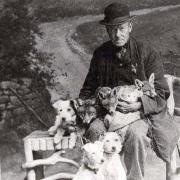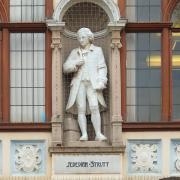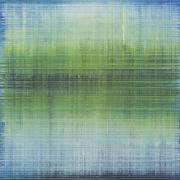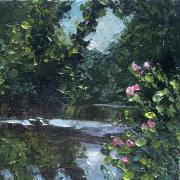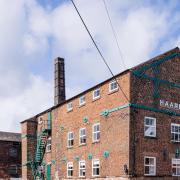Mike Smith meets the Hathersage-based, award-winning poet Katharine Towers

Having come late to the world of poetry, Katharine Towers, who lives in the Peak District village of Hathersage, has made up for lost time by making a remarkable impact with her first two collections. Her book, The Floating Man, published in 2010, was shortlisted for three major literary prizes and won outright the Seamus Heaney Centre Poetry Prize. And her second collection, The Remedies, published in 2016, was shortlisted for the prestigious TS Eliot Prize.
Even people who do not normally read books of poetry are almost certain to love The Remedies, because so much of the book is based on an idea that is not only brilliantly original but also makes the poems very accessible. Before considering how Katharine came up with her clever concept, it is fascinating to learn how her much-praised first collection came about.
Katharine was born and brought up in London. She attended a comprehensive school up to the age of 16 before transferring to a sixth form in a private school, from where she gained entry to Oxford University. Having always been an avid reader who would read books under the bedclothes with a torch, she opted rather surprisingly to read Languages at Oxford rather than English. Explaining her choice, Katharine said, ‘I knew that I would always continue to read lots of books written in English but felt that my degree would give me access to French literature as well. As it turned out, it also gave me a profound love of language, whether that be French or English.’
Following graduation, Katharine found work as a journalist for the publishers McGraw-Hill, where she met her future husband, Andy, who was in the marketing department. She said: ‘Although I was writing for a technical publisher, I found myself working in an office where everyone had ambitions to be an arts journalist – we all dreamt of working our way onto the arts pages of The Guardian.’

After spending several years working and living in London, Katharine and Andy decided that they would like to move to the North of England. Andy established a PR business that he could run from home, wherever that might be, and Katharine applied for teacher-training courses at northern universities. It was the offer of a place at Sheffield University that enabled the couple to relocate to the Peak District.
Unfortunately, Katharine’s first teaching job proved to be very challenging. Realising that she had been ‘too idealistic about the profession’, she gave up her position after one year. However, she had no intention of abandoning her long-standing ambition to be a writer. When a novel she had written was rejected by publishers, because it ‘lacked narrative drive and was too short’, she tried her hand at writing short stories until the birth of her two children limited the time she could devote to any form of story-writing.
Explaining how this restriction became a blessing in disguise, Katharine said: ‘Because the demands of child-rearing meant that I only had small amounts of free time available, I began to write some short poems and I soon realised that this was the perfect creative form for me. I’m not really interested in narrative but I am very passionate about language. Every word counts in the small space of a poem, so writing poetry allows me to indulge in my love of tussling with words.’
Having finally chosen her direction as a writer, Katharine embarked on a creative writing course at Sheffield Hallam University, where Sean O’Brien was the Professor of Poetry and would become her tutor. When Sean moved to Newcastle University, Katharine completed her Creative Writing MA at that institution by submitting a collection of 30 poems. Impressed by their quality, her tutor showed the poems to his publishers, who accepted them for publication under the title The Floating Man.

Looking back on that first prize-winning collection, Katharine said: ‘Music and Nature were at the core of the poems. I had joined a Sheffield choir and I was spending a lot of time listening to music. I was also living close to countryside where I could walk among nature and listen to words that came into my head. As I regard poetry as being like music because it is about beautiful sounds, I was very excited when one of my poems that had been chosen for display on the London Underground was noticed from a passing train by a musician called Laura Stevens, who asked me if she could use it.’
The poem that had caught the musician’s attention is called ‘The Way We Go’:
the way we go about our lives
trying out each empty room
like houses we might own
eavesdropping for clues in corridors until
standing at a gate or attic window
seeing beauty in a flag of sky
we’re gone, leaving the doors open
all the lights burning
For many of the poems in her second collection, The Remedies, Katharine took her inspiration from her love of flowers – her children are even called Bluebell and Daisy. Commenting on an exhibition she had visited at the Tate Modern that showcased paintings by Georgia O’Keeffe, who makes enormously enlarged images of flowers, Katharine said, ‘O’Keeffe’s magnified flower paintings allow the viewer to focus on fine details, just as reading and writing poetry can have the effect of stopping the clock to allow us to find time to concentrate on small things.’
Katharine had also studied the meticulous illustrations in her father’s copy of The Concise British Flora in Colour by W Keble Martin. Even more importantly, she had read about ‘flower remedies’, comprising various dilute solutions of flower material identified by Dr Edward Bach as cures for 38 different psychological conditions, such as fear of the unknown, apathy and jealousy. After learning of the ‘remedies’, Katharine came up with the novel idea of imagining how each flower named by Dr Bach could experience the very condition it is meant to cure.
One poem to emerge from this highly original notion is called ‘Rock Rose, a remedy for terror’:
I can’t look down
from this chalky brink.
As I cling, I listen
to the large sea
rummaging for where
the cliffs are soft, or thin.
Other poems in the collection include ‘Holly, a remedy for hatred and jealousy’:
I’m expert in subtle vexations.
I can stitch a thread of blood.
You see I can’t love.
My dark green heart is good for nothing.
Always trotting out this same old hard-luck story . . .
Don’t cry or I’ll scratch out your eyes.
The success of Katharine’s first two poetry collections has brought her invitations to literary festivals and offers of work from the Poetry Society as a leader of poetry surgeries and workshops. She also has a part-time job as an assistant editor at Candlestick Press, a Nottinghamshire-based publisher of poetry pamphlets. She says, ‘With work also progressing on my next book of poetry, I now have the enormous satisfaction of my working life being concerned entirely with poetry.’
When pressed to reveal the form of her upcoming book, due to be published by Picador in 2020, Katharine disclosed that it will take the form of a single, unpunctuated, book-length poem. This brave departure from her first two collections of short poems is a sure sign of the confidence that Katharine has gained from the critical acclaim that greeted The Floating Man and The Remedies.
Katharine Towers’ poetry collections, The Remedies and The Floating Man, are published by Picador.










